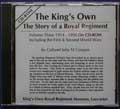 |
King's Own Royal Regiment Museum Lancaster |
||||||
|
HOME Museum & Collections Soldiers of the Regiment Sales Donations Events Contact Us REGIMENTAL HISTORY 17th Century 18th Century 19th Century 20th Century First World War Second World War Actions & Movements Battle Honours FAMILY HISTORY Resources Further Reading PHOTO GALLERY ENQUIRIES FURTHER READING LINKS |
Regimental History - 20th Century Second World War 1939-1945 7th Battalion, King's Own Royal Regiment, Lancaster Formed in February 1940 the 7th Battalion went out to France in April 1940 in order to assist with the construction of defensive works. Following the German invasion on 10th May the battalion was ordered back to Dunkirk and the UK. On their return to the UK they were employed on anti-invasion duties whilst they awaited the expected German invasion. In June 1942 the Battalion went to Gibraltar and then onto India in March 1943, where it remained until after the war. Despite intensive training it was never to see active service. 14th February 1940 Battalion formed at Dover The battalion is made up of officers and men from many different regiments, not just the King's Own. It was one of four pioneer battalions formed in the Regiment in February 1940. 25 April 1940 7th Battalion arrive in France 10th May 1940 German advance begins German aircraft bomb the 7th Battalion but they receive no casualties. 26th May 1940 Battalion withdraws from Belgium 27th May 1940 Battalion under attack The 7th Battalion come under attack from the German forces across the River Lys. The battalion are successful in shooting down an aircraft with a Bren gun and capture the pilot. The order to withdraw is later received. 29th May 1940 7th Battalion withdraws from Dunkirk
June 1940 Home Defence begins
22nd July 1940 - 100 other ranks were posted to the 6th Battalion, King's Own Royal Regiment. 1st August 1940 - The 7th Battalion arrives at Newark in the East Midlands. The battalion provided aerodrome guards at Woolsthorpe; Swinderby; Winthorpe and Balderton. 7th September 1940 - The 7th Battalion receive the signal 'Cromwell' which was the indication that a German invasion was imminent. All road blocks were manned and all guards and detachments 'stood to'. The alert remained in place until 19th September 1940. 29th October 1940 - The battalion moves to Stamford and came under the command of 2nd Infantry Brigade. 15th November 1940 - The 7th Battalion is converted from a pioneer battalion to an infantry battalion. 21st June 1942 - 7th Battalion sails for Gibraltar The 7th Battalion embarks on board HMT Narkunda on 21st June 1942 from Greenock on the River Clyde, Scotland, to re-enforce Gibraltar. The 7th Battalion arrive in Gibraltar on 28th June and disembark the next day. More on the 7th Battalion in Gibraltar 2nd September 1942 - 7th Battalion embarks Gibraltar on board HMS Ramilies and HMT Leinster. 8th September 1942 - HMS Ramilies docked at Plymouth and the 7th Battalion disembarks. 12th September 1942 - HMT Leinster arrived at Greenock on the Clyde and the 7th Battalion disembarks. 14th December 1943 - 7th Battalion, embarks for India The battalion embarked on HMT Mataroa from Avonmouth. They docked at Freetown on 1st January 1943 and arrived in Durban, South Africa on 18th January 1943. The battalion disembarked the next day. On 1st March 1943 the battalion left Durban on board the TMS Dempo, a ship of the pre-war Dutch Rotterdam-Lloyd Line. The 7th Battalion arrived in Bombay on 17th March and they disembarked the ship two days later. 19th March 1943 7th Battalion, King's Own disembark in India The 7th Battalion disembark the TMS Dempo at Bombay and move to Lahore. The Battalion remained in India until the end of the war and were employed on internal security duties and did not see any active service against the Japanese, much to the disappointment to many of the men.
The King's Own Ibalur Parish
Magazine, June 1946
Only a proportion of our collections are on display at anyone time. Certain items are on loan for display in other institutions. An appointment is required to consult any of our collections which are held in store. |

